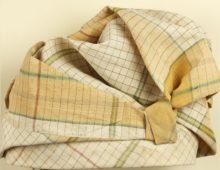Was change in medical practice revolutionary or evolutionary during the Age of Revolution? Enquiry focus 2
The Old Operating Theatre
Suitable for students aged 14+
1. Watch
Ask students to watch the Operating Theatre video. Ask them to write down any important points about the development and use of operating theatres in the period.
If you are watching with the students, pause the video to help them reflect on the questions below as well as considering the types of questions the historians are asking. How does Mick Crumplin use his knowledge of surgery to explain the historical development of the objects?
Can students answer the following questions?
- What was new about the operating theatre?
- What were some of the positives/negatives of the layout of the operating theatre?
- How did the operating theatre have an impact on the development of surgical techniques?
2. Test
Students can try this multiple choice quiz to see how much they have remembered from the video. Students working at home can save their answers as a PDF and email them to teachers.
3. Research
In the video there is some discussion about the increasingly professional nature of surgery and medical practice. Ask students to conduct some independent research on medical training and professional bodies such as the Royal College of Surgeons during the Age of Revolution and produce a mind map to show their findings. They should think about:
- where people studied medicine
- how studying and training changed during the period
- how this is different from what we think of as medical training in the 21st century
Students could be encouraged to think about wider questions relating to the professionalization of medicine. The changes in who practiced medicine (from religious orders and women to professional barber surgeons and then qualified practitioners) could be an interesting point of discussion and reflection.
4. Connect
There are clear connections made in the video between the importance of new technology to the Old Operating Theatre and the impact on medical technology of the theatre itself. Ask students to look at two other objects from our Revolutionary collection which show the impact and uses of different technology:
The Earl of Uxbridge’s prosthetic leg
For each object they make notes about how it:
- shows the use of new technology in the period
- demonstrates how peoples’ lives were changing during the Age of Revolutions.
Different groups of students could be asked to explore different objects from the Economic and technological revolution theme to develop a sense of the period.
5. Think
Ask students to think about whether the developments in surgery during the Age of Revolution show evolutionary or revolutionary change. Is this the same for other periods of surgical development? In class this could be completed through paired or small group discussion. If students are studying at home they could be encouraged to use email or virtual chats to discuss these ideas.
6. Reflect
This enquiry focuses on the patterns of change in medical practice that we can see during the Age of Revolution and whether this was revolutionary or evolutionary. Ask students to produce a diagram to show their thoughts about what sort of change the Old Operating Theatre brought. They could use a diagram like this example.
Explain that the centre of the diagram represents an evolutionary change i.e. something slow and steady; possibly with some points of regression (backwards movement). The outside of the diagram represents revolutionary change i.e. something fast and explosive which changed peoples’ lives or ideas rapidly.
There are five points between the centre of the diagram and the outside. First, students decide whether they think the change brought by the Old Operating Theatre was evolutionary, revolutionary or somewhere in between on a scale of 1-5 and mark this on the diagram with a cross. They then add brief notes to explain why they have chosen to give vaccination this score.
As they study more objects from this overall enquiry, they will add to this diagram to get an overall impression of whether they think medical change in the period was evolutionary or revolutionary. As students develop their diagram of the pattern of change encourage them to think about the criteria they are using for deciding whether a change is evolutionary or revolutionary. They should also be encouraged to explore other themes to broaden their knowledge and understanding of the period.
7. Extend
The Old Operating Theatre has a website where you can read more about the history of the site and the objects it looks after. Students could look at the Old Operating Theatre’s website and add anything interesting to their notes.
This website could also be used to support a wider class investigation into medicine in this period.
Try the other enquiries in the series
Was change in medical practice revolutionary or evolutionary during the Age of Revolution?
Enquiry focus 1 – Vaccination
Enquiry focus 2 – The Old Operating Theatre
Enquiry focus 3 – Phrenology
Enquiry focus 4 – The stethoscope
Consolidate your thinking – Change in medical practice during the Age of Revolution
What factors drove change in medical practice during the Age of Revolution?
Enquiry focus 1 – The kymograph
Enquiry focus 2 – Anatomical research and Charles Bell
Enquiry focus 3 – Surgical instruments
Enquiry focus 4 – Early anaesthetics
Consolidate your thinking – Drivers for change in medical practice during the Age of Revolution


